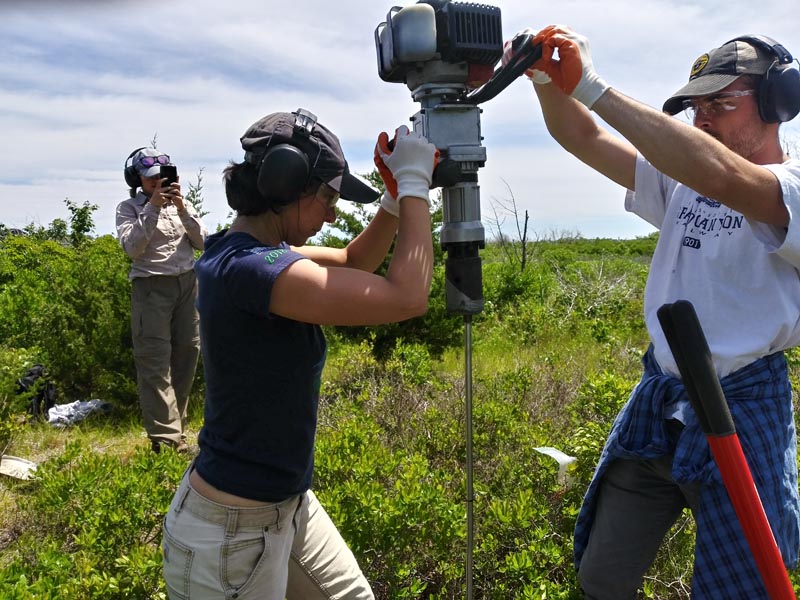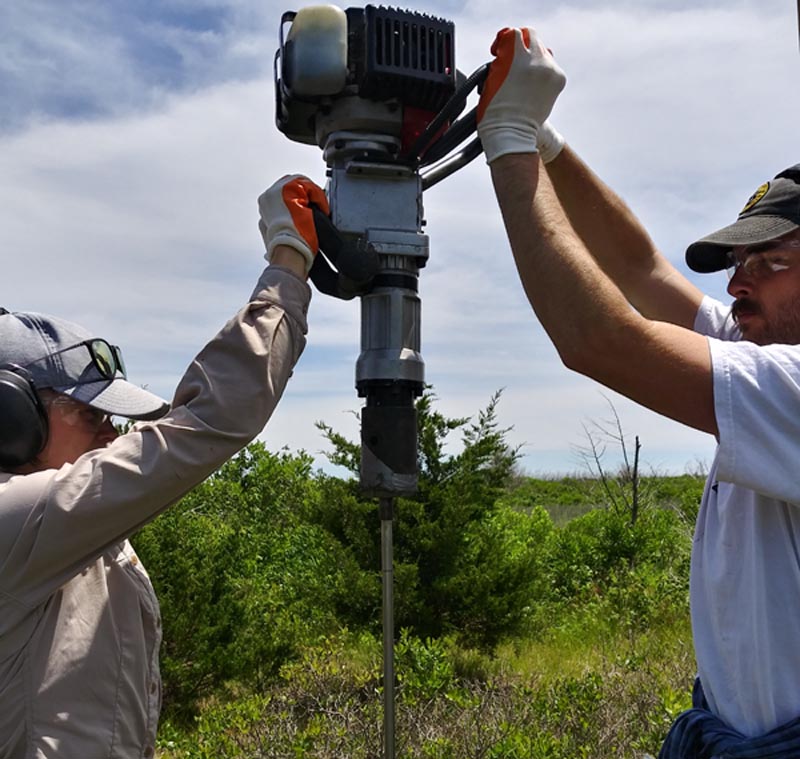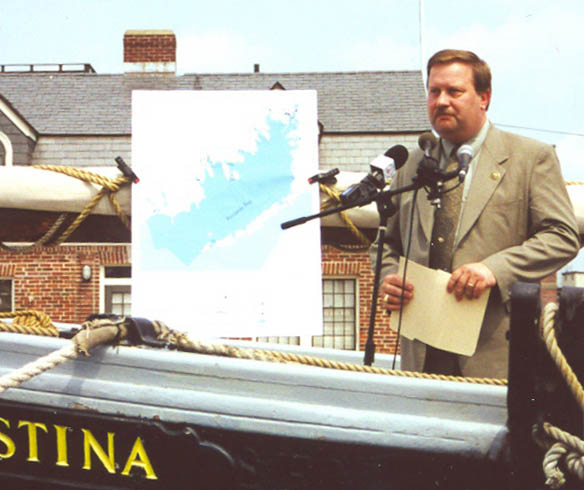In 2020, the Buzzards Bay National Estuary Program achieved many successes despite the challenges and restrictions imposed by the COVID pandemic. Below we list some completed and ongoing tasks from our ongoing workplans. In 2021, we look forward to continuing our support to Buzzards Bay municipalities and our non-profit partners in their efforts to protect and restore water quality and living resources in Buzzards Bay and its surrounding watershed through the implementation of the Buzzards Bay Comprehensive Conservation and Management Plan.
CZM’s South Coastal Regional Office and Buzzards Bay National Estuary Program Offices Moved – In January, the CZM South Coastal Regional Office and the offices for the Buzzards Bay National Estuary Program moved from Wareham to Mattapoisett. The new address is: 81-B County Road, Suite E, Mattapoisett, MA 02739. The new phone number is (774) 377-6009. However, due to COVID-19 the new office remains closed and staff are working from home.
Local Stormwater Treatment Projects – In May, the Buzzards Bay NEP retained the Horsley Witten Group to prepare engineered designs and supporting calculations for a series of projects to treat stormwater runoff. The goal of the project was to develop construction-ready stormwater management plans for three critical drainage catchments that currently discharge untreated stormwater to Buzzards Bay. The sites were selected from 15 high priority catchments in Acushnet, Dartmouth, Fairhaven, Mattapoisett, and Wareham where monitoring data and stormwater network information had been gathered through the Buzzards Bay Stormwater Collaborative, there was potential interest from municipalities, and other factors. Six of these sites were selected for conceptual designs based on review by the Horsley Witten Group, the NEP, and town recommendations. In October, three sites were selected in Acushnet, Dartmouth, and Fairhaven. Permitted designs are expected by February 2021. The Buzzards Bay NEP intends to work with municipalities to secure funds to implement these final designs. In December, a fourth site was selected for the development of stormwater treatment plans by civil engineering students in the UMass Dartmouth Civil and Environmental Engineering Department. This work, funded through a SNEP-funded collaboration between the University and the NEP, will be completed in May 2021. For more information, including ongoing updates as the project progresses, see the Buzzards Bay NEP website.
Buzzards Bay Municipal Mini-Grant Program – In December, EEA announced $125,606 in federal grants for land protection, septic system tracking, and town bylaw amendments that will protect water quality and habitat in the Buzzards Bay watershed. The Municipal Mini-grants were awarded by the Buzzards Bay NEP through CZM with funding from SNEP. The six grants are being matched by over $203,000 in private and municipal contributions and in-kind services. The following grants were awarded:
Acushnet – $15,000 to purchase and permanently protect several parcels of undeveloped forest land, for a total of 99 acres. This land is located in the headwaters region of Tripps Mill Brook—an important tributary to the Mattapoisett River, which is the primary source of drinking water for Acushnet and four surrounding towns.
Carver – $8,500 to revise its existing Transfer of Development Rights (TDR) bylaw to better position the town to preserve land and encourage appropriate and balanced development.
Carver – $20,946 to purchase and permanently protect two parcels of forested land totaling 32 acres. The properties are located over medium and high yield drinking water aquifers, lie along a tributary of Indian Brook in the Upper Weweantic River watershed, and abut existing conservation lands.
Marion – $50,000 to protect more than 36 acres of land in the Aucoot Cove watershed through a combination of land acquisitions and conservation restrictions. Protection of these lands, which contain designated habitat for rare species, will build on a larger block of existing conservation land.
Rochester – $20,946 to purchase and permanently protect 232 acres of land located within a large contiguous undeveloped forest area at the headwaters of the west branch of the Sippican River. The property includes Atlantic White Cedar Swamp, important state-designated habitat, and 65 acres of cranberry bogs.
Westport – $10,214 to join the Barnstable County Department of Health and the Environment’s Innovative and Alternative Septic System Tracking Program. These innovative septic systems are designed to release significantly less nitrogen than conventional Title 5 septic systems, but are also more complex and require regular monitoring to ensure they are meeting established nitrogen standards.
For more information, see the EEA Press Release.
Buzzards Bay Targeted Grants – In September, with SNEP grant funding, the Buzzards Bay NEP initiated four new projects. The Buzzards Bay NEP will continue to support a study by the Ecosystem Center at the Marine Biological Laboratory to evaluate the feasibility of applying permeable reactive barrier technology, using wood chips as a carbon source, to reduce nitrogen inputs from advanced treated wastewater effluent under different controlled flow conditions. This work is being undertaken in partnership with the Wareham Water Pollution Control Facility. The NEP is also supporting a study by the Woodwell Climate Research Center of Woods Hole to measure nitrogen inputs to Buzzards Bay from coastal rivers. In the third project, the Buzzards Bay NEP entered into partnership with UMass Dartmouth to fund both a senior studies project and a graduate student research project to develop stormwater treatment designs and conduct investigations of illicit connections and pollution sources in stormwater networks. In the fourth project, the Buzzards Bay Coalition is assisting the NEP in a Climate Vulnerability Assessment of the Buzzards Bay Comprehensive Conservation and Management Plan. The Coalition will host meetings and workshops with key stakeholders, synthesize responses, and help develop new recommendations for management action in Buzzards Bay. Besides these projects, the NEP continued to support the Buzzards Bay Coalition’s Baywatchers program with a $40,000 grant. All projects will continue through the fall of 2021.
Buzzards Bay Salt Marsh Study – Salt marshes in Buzzards Bay provide a vital role by providing habitat, regulating water quality, and stabilizing coastlines. In recent years, many coastal towns have experienced the degradation or loss of their salt marshes. To better understand and halt this trend, the Buzzards Bay NEP continues to support efforts by the Buzzards Bay Coalition and scientists at the Woodwell Climate Research Center to study salt marsh loss in Buzzards Bay. In a Buzzards Bay NEP/Buzzards Bay Coalition long-term study, historical loss of salt marshes is being documented by the NEP using aerial photographs, while the Buzzards Bay Coalition is documenting annual changes in marsh vegetation and elevation. In particular, the effort is focusing on how climate change, pollution, and changes in the abundance of certain crab species may be affecting salt marshes. In a second SNEP-funded study, scientists are looking at how use of runnels—constructed shallow drainage meanders—might promote revegetation where upper areas of salt marsh are dying off from standing water. In both studies, the Buzzards Bay NEP is providing GIS mapping analysis using recent and historical aerial photographs and LiDAR data. The NEP also installed elevation benchmarks, conducted elevation surveys using laser levelers and Geographical Positioning System (GPS) equipment, and provided training on the use of the equipment by NEP partners. The results of this work will help town officials and state and federal mangers develop possible mitigation strategies to protect and restore salt marshes. For more information, see the Salt Marsh Study web page.
Continued Support to the Buzzards Bay Stormwater Collaborative – The Buzzards Bay NEP is a partner with the Massachusetts Maritime Academy (MMA) and eight participating municipalities on a SNEP grant to monitor stormwater discharges and map stormwater networks, particularly those contributing to shellfish beds closures. Despite limitations imposed by the COVID-19 closures and a summer without much rainfall, the project continued to meet milestones. MMA co-op student participants continued to map stormwater structures, sample discharges, and support municipalities in their MS4 efforts through individual contracts. The Buzzards Bay NEP provided technical oversight and continued data processing and analysis.
Video Series on Stormwater Discharges – In January, MMA received a MassDEP grant on behalf of the Buzzards Bay Stormwater Collaborative to outfit a trailer for municipalities to use to conduct Illicit Discharge Detection and Elimination investigations. The trailer is housed at MMA and is now available for any of the Stormwater Collaborative municipalities. The Buzzards Bay NEP was a partner on the grant, and directed the construction and equipment specifications. Hands-on training for town officials on how to use the trailer and its equipment has not been possible due to COVID-19. The Buzzards Bay NEP and MMA, with permission from MassDEP, developed a series of YouTube videos for training purposes. These videos provide information on some stormwater basics, considerations for MS4 permitting, GIS mapping techniques, and sampling protocols currently used in the ongoing monitoring program. For the video series, see the Buzzards Bay Stormwater Collaborative YouTube channel. The Buzzards Bay Stormwater Collaborative page has additional information about the collaborative, and these and other useful stormwater monitoring training videos are on the Collaborative’s Monitoring Discharges page.
Technical Assistance – The Buzzards Bay NEP continued to assist municipalities and other partners with GIS analysis, proposal development, review of local projects, and training and support for municipal stormwater permits (MS4) compliance. The NEP provided more than 675 map and GIS products to the Buzzards Bay Coalition, area land trusts, and municipalities in their efforts to protect important habitat and open space in Buzzards Bay. The Buzzards Bay NEP continues to work with the Buzzards Bay Coalition Science Advisory Committee and a team of scientists in Woods Hole to identify pressing issues related climate change, nitrogen and toxic pollution, and loss of wetlands habitat and living resources in Buzzards Bay.
Support to SNEP and SNEP Grant Awardees -The Buzzards Bay NEP is an advising SNEP partner, and is a supporting partner to several SNEP grant awardees. SNEP supports partnerships to address water quality and coastal habitat issues in the region. In August, Restore America’s Estuaries and EPA announced $1.8 million in funding to six local partnerships in Massachusetts through the Southeast New England Program Watershed Grants. The awards included one to the Buzzards Bay Coalition totaling $118,275 for the Multi-Community Collaboration to Reduce Nitrogen in Upper Buzzards Bay. The Project includes completing engineering and other studies to expand the capacity and service area of the Wareham wastewater treatment plant. Earlier SNEP grants included one to the Bay Coalition for the Salt Marsh Runnel Study, and the grant to Massachusetts Maritime Academy to support to the Buzzards Bay Stormwater Collaborative. Throughout 2020, and continuing into 2021, the Buzzards Bay NEP will continue to provide technical support to these efforts.



